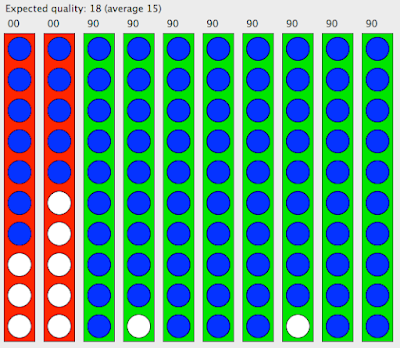IT#21 New Hire Dilemma - The Better the Company the Worse is Your First Team
#IT, #ITManagement, #ITManagementTheory, #ITHiring,
This article explains that in some cases getting hired by a great company is not a guarantee of a great team or a manager, and sometimes actually the opposite.
Imagine that you've got hired by a great company, at least so “The Best Employee” polls say. Great, is not it? Don't jump to conclusions yet. Let's look how it works inside.
First let's create a model. Assume the company has 10 teams with 10 positions in each. Also, assume that all teams are filled 90%, and so each team has one headcount. By the way, this model is implemented in Java and available on the GitHub (it was actually first done around 2010, and I re-implemented it in 2023).
Now, remember? The company is great! Which means most of the teams are good. But the cannot be all good, so let's assume a couple of them is bad. Let's say, 90 (green) is good, and 0 (red) is bad. What will we have after N iterations? Here it is:
You see, two things are happening:
1. Bad teams loose people due to internal transfer or people leaving the company, one way of another driven out by poor management.
2. Good teams are filled through the internal transfer and don't have vacancies. People normally don't leave good teams.
The result for you as a new hire? Most vacancies are located in bad teams, either with bad culture, or poor management, or both. And that's what you get.
More specifically, on the picture above with chances 8 to 2 you get into a very bad team. And if you play with the model more, you will occasionally see when that chance is 100%.
What if the company is not so great and the teams in the company are consistently more on the poor side? Of course, no company can survive if all the teams are really bad (red - 00), but they are not that great either (not green - 90). They are kind of so-so (50). What will happen next? Here it is:
You see? All vacancies are consistently average, that is 50. You are guaranteed to get the average quality of the team, which is much better that what you were getting in the “good” company.
Hence the title of this article: the better the company the worse is you first job in it.
The last experiment I'd like to show you is what if the quality of the teams are more smoothly distributed? Say it changes from 0 to 90 with an equal step? Alas, it's not that better:
In this particular run we ended up with average expected quality of the team 23 instead of the “good” company 15, and again with chances of 8 to 2, you getting a worse team than in a consistently average company.
The “good” company is still worse than both other companies, and the reason for poor first team is inconsistency of the team quality across the company.
Disclaimer
Of course, in today's (2024) screeching halt hiring economy getting a job is still great. Just, don't have your expectations too high.
Zurich, Apr 25, 2024



Эволюция работает и так тоже.
ReplyDeleteУ тебя есть немножко сомнительное условие. То, что внутренние перемещения из группы в группу в компании проходят легче, чем найм со стороны. Из моего опыта это не всегда так.
Наверное в FANG это так, потому что найм со стороны - очень длительная и дорогая операция.
Но, даже если это условие убрать, то все равно твой закон будет работать.
Я бы еще для реальности добавил довольно частые изменения в размере и составе групп. Если условно считать что группа == проекту (направлению), то проекты постоянно пульсируют, раздуваются или сдуваются. Соответственно потребность в дев.ресурсах.
И этот фактор, "динамика проетов" (или можно назвать "динамика загрузки девов") может быть сильнее фактора "перемещения девов между группами".
Вообще... классные у тебя "законы". Я тоже парадоксы обожаю. Респект!